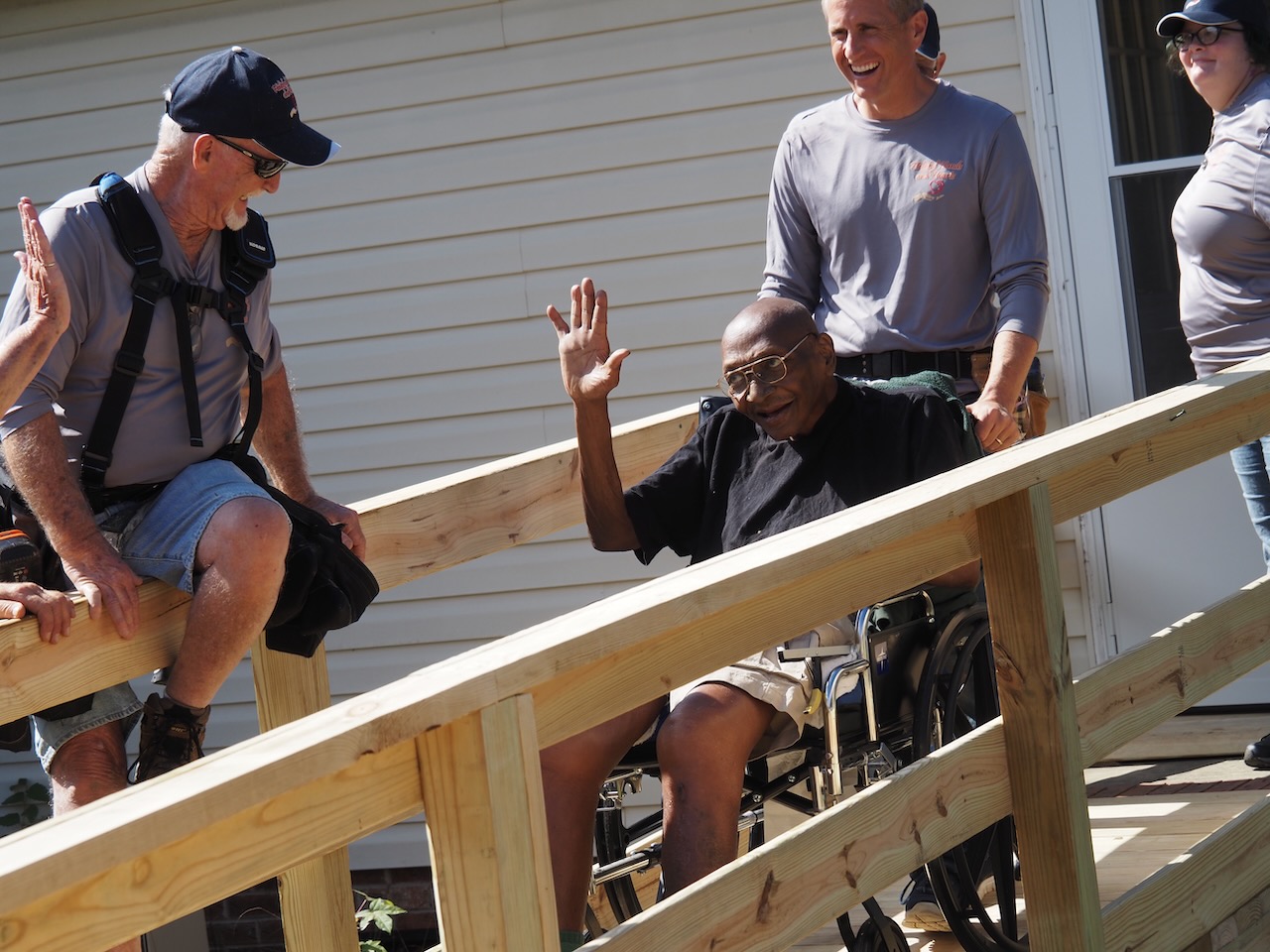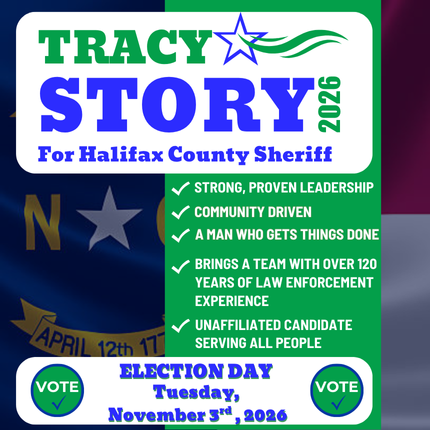Larry Haynes smiled and gave the thumbs up sign as he was wheeled out of his house and onto his newly completed ramp — the 300th Helpful Hands and Hearts have built since its formation.
Haynes spoke with Kirby Heyborne, the host of BYUtv’s show Making Good, which was filming an episode for this coming spring on the 300th ramp and what it meant to Haynes.
Haynes, an Air Force veteran, told Heyborne, “I love it. Freedom. Free at last, thank God almighty we’re free at last. The ramp is excellent.”
Haynes already received one smile when he made contact with HHH and, he said, “You brought a smile when you carried it through. That’s a blessing.”
Chuck Youse, the founder and executive director of HHH, told Haynes, “We are so glad we could do this. It makes us feel good. When we see you feeling good, we all feel good — we feel better than you do.”
Besides the new ramp, which was constructed and put up this morning, Haynes also got a new storm door for his residence off Highway 903 outside Roanoke Rapids. “God has given me this blessing. I truly, truly, truly enjoy the day and every day. In that house I’m locked down — no freedom or nothing but it worked out good. God’s on time all the time. He may not be there immediately but he comes on time.”
After a celebratory group photo, handshakes, and hugs from the construction team, Haynes said, “It means the world to me. It gives me some freedom with my disability. I’m able to get outside and at least go see my dog.”
Before the ramp family members would have to lift Haynes in the chair to take him outside. “This makes it a lot easier because I can move my foot to drive. I’ve just got to get strong enough to get in and out of the car.”
Seniors serving seniors
Youse said BYUtv found HHH on the internet and decided they wanted to film a segment on the organization and its work.
One of the unique aspects of the work HHH does is it’s seniors helping seniors, Youse said.
HHH began in 2004 when Youse was selected to attend the UNC Senior Leadership Academy — a one-year program. “Part of that program was you had to develop a program, some kind of program that would help seniors.”
At the time Lake Gaston Retirement Village was trying to build a continuing care retirement community. “The economy went south so they didn’t have anything to do and had this money laying around.”
The group got $10,000 of the funds to get HHH started. “It took two or three years before anybody believed what we were doing. We would go out and talk to people and tell them we would build a ramp for you, won’t cost you anything.”
In the early stages some people thought the idea of a no-cost ramp was too good to be true and would cancel, Youse said. “It took us to where we had built five or six ramps. Word started to spread and now it’s ballooned to the point where it’s beyond my control.”
Most of the volunteers, with the exception of probably one, are retired. “A lot of them are military folks. They just do this because they want to do it. They get more out of this than probably the people we build for because they feel really good when they’re done.”
The people the work is done for are called the group’s friends, said Youse. “They come out and they smile. They come wheeling down their new ramp. We have people say you’ve changed my life.”
Halifax County Health Director Bruce Robistow was one of the observers this morning, more so in his capacity as a United Way board member. “We’ve been providing funds to them for quite some time. They are conservative in their requests and fortunately we’ve had some good years where we could do a little bit more than they requested. After meeting with them and seeing what they do the entire board was moved by all the things they are getting done.”
Robistow said in a year where contributions will be less coming off of COVID, HHH uses every dollar “and they use it well. They pull out of their own pockets.”
And, Robistow said, building ramps is not the only thing the group does. “They drive people to doctor's appointments. They just do all kinds of great things and the United Way is just honored to be able to help support in some small way.”
Helping more than 300
Youse said 2012 was the year things came together. “Our waiting list for ramps is normally about 40. We try to build one a week. Sometimes we try to build two, but even at that you’re looking at a six-month wait to get built.”
Building the 300th ramp helps more than 300 people, Youse said. “We look at it from the perspective we’re taking care of our friends who need the ramp. At the same time we’re taking care of the caretakers of that friend who have had to struggle.”
There have been calls from EMS saying EMTs were afraid to carry a person out of a house because of the steps and wouldn’t do it. “We’ve had to drop our plans for whatever we were going to do and build a ramp for that guy so EMS would feel comfortable.”
Said Robistow: “It shows you the need was always there and how difficult it must have been on people before this organization stepped up.”
Youse said the need for ramps in the Roanoke Valley is widespread.
Haynes, for instance, fell in May, and it took four days to crawl to the telephone. “He’s retired Air Force. He’s not getting the proper compensation from the VA. We’re going to talk to the veterans person there. He should be getting 100 percent disability just because of unemployability.”
Youse said everyone in HHH who participates in building the ramps are humbled by the completed projects. “We hope we’re going to be able to continue to do that for as long as we can. It’s retirees helping retirees. I’m always afraid the force is going to get smaller but my volunteer forces are the biggest and best.”
The TV host
Heyborne, the host of Making Good, said the production office looks for organizations that are making the world a better place. “We heard about Helpful Hands and Hearts and they were exactly what we were looking for. In the show I need to do a lot of hard work and there’s nothing harder than sawing and drilling and digging. These guys are amazing.”
Heyborne said the amazing thing about the HHH members is they are retired. “Usually at this age people are sitting back and just fishing and relaxing and enjoying their glory years but not these guys. You’ve got a group of about 20 guys here on a Friday morning that could be doing anything else — they could be sleeping but they’re here making a difference in one man’s life.”
What is special about HHH, Heyborne said, “It’s retirees, it’s vets helping other retirees and vets and bringing together this community. They’re creating a community, making a community smaller by helping people that need help. For me, it’s just beautiful seeing all these people. You never think you’ll get emotional sawing a piece of wood but when you do it’s for someone else and I see that and it makes me feel happy about humanity, happy about where the world is, especially in Halifax. They make them good here.”
Sherwood Boatwright, the father of Haynes’s great nephew, said he gave Haynes the phone number for the organization.
Boatwright said the work done today means that he and other family members don’t have to struggle to get their loved one down the steps anymore. “He can come down on the ramp by himself.”
Observers
Watching the work being done were members of the Upper Coastal Plain Council on Governments as well as the Halifax County Council on Aging.
Linda Barfield, assistant program director for the Upper Coastal Plain’s area on aging, said, “Obviously, we’re super excited. We were here when they did the 100th and built the 200th and now we’re back for 300. We’re excited because it does help further our mission which is to help older adults live happy, healthy, dignified lives in their own homes, in their own communities which is something you can see this ramp is going to do for the person here. It just solidified everything that we work hard for every day.”
Part of the funding that pays for this for people 60 and older comes from the Older Americans Act, Barfield said. “Our office was actually established by the Older Americans Act. We’re one of 16 area agencies on aging that covers all 100 counties. With that big responsibility we work with each county to help them best figure out how they want to best prioritize and spend their Community Care Block Grant money.”
Each county is allocated a certain amount of funds, Barfield explained. Nonprofits such as HHH bid to get to a slice of the funding. “For what we give them, they do way more. They also serve people under 60 which wouldn’t be covered by our funds. I like to say we’re one of the funding partners — not the only funding partner.”
Rose Lewis, the aging program coordinator for Halifax County, said the work HHH does symbolizes dedication and commitment.
Barfield said the work done today also speaks to the work Lewis is doing in the county. “It says we’re on the right track. It says we are doing something right.”
Lewis said the ramps and the service they provide “is awesome. The volunteers are awesome. There are plenty of times I’ve been able to contact them with someone who just came home from the hospital and needed a ramp built to get to dialysis or a ramp built to get to the doctor, to get out of the house. It’s awesome. The most marvelous thing about it too is this is one of the fundings sources but if they come out and there’s another need, they were able to provide the storm door and there’s been cases when they come out that they’re able to provide them with a stoop.”
Rebecca Stapleton, an aging program specialist in information and options counseling programs, helps to put people who need resources in touch with the people who need the work done. “The need is great in a lot of areas but especially this area.”
Mobility is a great need, Stapleton said. “It’s a necessity and in order for folks to remain in their homes they have to be able to access those services. That’s what this does. It puts that person at home where they want to be and able to get out and get to where they need to be able to get to.”
Anetta Brown, a long-term care ombudsman and an advocate for those in long-term care, said, “I know for a fact that having a ramp built to your home prevents you from having to go into a facility. A lot of times you have someone that can’t get out of their homes to get to the doctor, to get to the grocery to get whatever they need and they fall. That starts the trickle effect of them going into the hospital and a nursing home. It’s a safety aspect of having this, especially for this person that’s receiving it.”






